- Home
- Encyclopedia
- Thunder Under The House: One Family and The Han...
Thunder under the House: One Family and the Hanna Mine Disasters
One Saturday afternoon in March 1908, 17-year-old Mary Hughes was making a pudding in the kitchen of No. 77, the seventh house in the first row of houses in One Town in Hanna, Wyo. The kitchen was warm and smelled of her warm pudding and the coal fire in the cookstove. Her father, Charles Hughes, watched her and tried to remember Mary’s mother’s pudding recipe. Mary’s mother had died years earlier, before they left England. For some time, Mary had been the main cook in the family.
Today, however, Charles Hughes’ mind was as much on the coal mine underneath them as it was on Mary’s pudding. The mine was on fire.
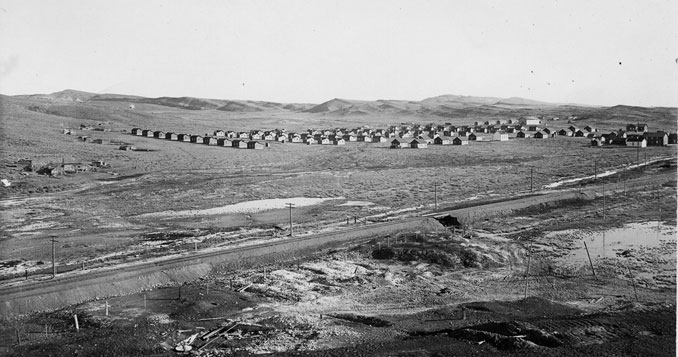
Mining underground
Hanna was a company town. Its dirt streets were straight and orderly. Its small houses were nearly all alike, with four rooms and a privy out back. The streets ran up the low hills away from the railroad and into the sagebrush. Front Street, lined with a single row of small stores and a boarding house, ran along the tracks’ north side.
The houses on the south side of the tracks made up Number One Town, more often just called One Town. Miners who lived in One Town all worked in the company’s No. 1 Mine. Two Town consisted of the houses on the north side of the tracks, stretching up behind Front Street. Miners in Two Town all worked in the company’s No. 2 Mine. More than half the miners had families. The rest were unmarried.
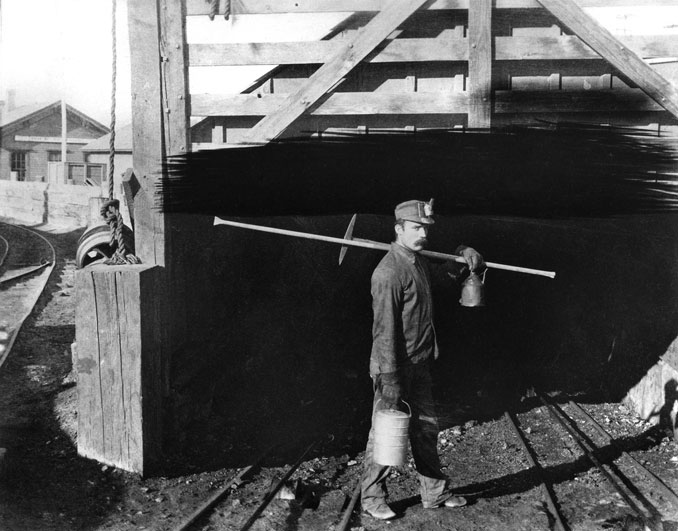
All the mines in Hanna were underground. Main tunnels sloped down to side tunnels, called entries, which led off either side of sloping main tunnels. The entries led to rooms underground.
The rooms had walls of solid coal, sometimes thirty feet high. Down there, it was pitch black all the time. To light his work, each man wore a little lamp with a small, open flame on the front of his hat.
Holding a hand-cranked steel drill at shoulder height, one miner drilled a hole into the coal. At the same time his mate, crouching on the ground with a pick, worked to undercut the face—the wall of coal. They filled the hole with blasting powder. Then they lit a fuse, left the room and the blast brought the face down. They loaded the loose coal onto small cars, which ran on tracks out through the entries. Some of the cars were pulled by mules. Some were hauled up the slopes by cables connected to big steam engines outside, at the top.
Railroad coal
The Union Pacific Railroad locomotives ran on coal and needed a constant, steady supply to keep on running. Coal deposits at Carbon, near Medicine Bow; at Rock Springs; and at Almy, near Evanston, determined the railroad’s route across Wyoming in the first place. Mines opened at Carbon and Rock Springs in 1868 and in Almy in 1869.
In the early years, the miners were mostly immigrants from the British Isles. Later, when the British miners went on strike, the company brought Chinese miners to Rock Springs and Almy and Finnish miners to Carbon. Bad feelings of the Anglo miners toward the Chinese led to the Rock Springs Massacre in 1885, when 28 Chinese miners were killed. Strikes and walkouts continued as company officials fought to keep wages low and the coal flowing out of the mines at the same time.
Dangerous work
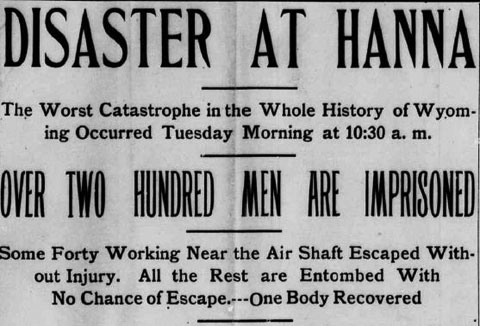
The work itself was very dangerous. Mines in the early days had few safety features. They often lacked extra air shafts for ventilation, extra exits in case of cave-ins or timbers strong enough to hold up the roofs in the tunnels and rooms.
Men died in large groups before the true hazards became apparent to government officials. Most miners died in scattered accidents where one or two were killed, but in 1881, an explosion and fire killed 38 men at a mine at Almy. Five years later, 13 more men died the same way in the same mine. Finally, the Wyoming Legislature passed a batch of safety laws. A state mine inspector would be required to inspect every Wyoming coal mine at least once every three months. Boys under 14 and women were prohibited from working underground.
Some of these same ideas were included in Wyoming’s new state constitution in 1890. On the theory that fatigue was the main cause of accidents, the delegates who wrote the constitution limited the workday in the mines to eight hours.
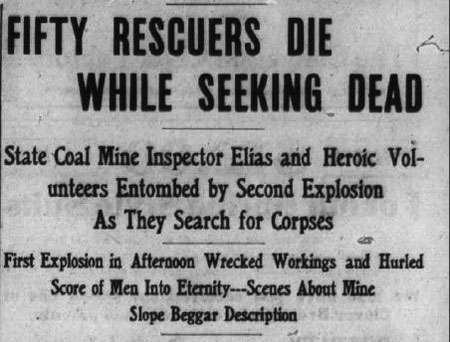
Still, accidents kept happening. Sixty-two men were killed in an explosion near Evanston in 1895. Twenty-six miners were killed in a cave-in at Diamondville near Kemmerer, in February 1901. Eight months later, 22 more were killed in the same mine. The Legislature passed more laws. The state mine inspector was given the power to hire deputies. Inspections were required even after non-fatal accidents.
Meanwhile, the trains got faster and the railroad got busier and more efficient. The tracks were rebuilt all across Wyoming—curves straightened and steep grades flattened. By the end of the 1890s, though, the mines at Carbon had about played out. In 1902, Carbon’s mines closed for good. A new railroad route went through Hanna, 12 miles north, where new mines had opened up earlier. Most of the miners from Carbon simply moved to Hanna and kept right on working.
While the town of Carbon had been scattered and disorganized, with perhaps as many dugouts as houses, Hanna was planned. The Union Pacific Coal Company owned everything: the houses, the store, the boarding house and the community hall. Miners could rent the houses for $12 per month.
Thunder under the house
The fire in the mine that caused Charles Hughes to worry that March Saturday in 1908 had been burning underground for weeks. Such fires happened from time to time, and often they burned themselves out fairly soon. This time, when the fire kept burning, the company officials had directed the miners to wall off the fire and continue operations in the rest of the mine. Now, however, the bosses decided the fire had burned long enough. Charles Hughes and most other miners from the No. 1 mine were not working that day because some experts had been called underground to figure out how to put the fire out.
At 3 p.m., Boom! Mary felt the floor shake, and the dishes rattled. Throughout her life, she would remember the sound “like thunder under the house,” as she told the story later. Her father grabbed his coat and hat and left. The dog followed him out the door. She never saw either again.
Two mining families
Martin Stebner, a blacksmith, came to Carbon from Germany with his wife, Amelia, and their six children in the 1880s. Martin’s son Bruno and his brothers went to work in the mines when they were still in their mid-teens. When the mines closed in Carbon, the Stebners moved to Cambria, a coal town near Newcastle in northeastern Wyoming, where they lived for a few years.
While in Cambria, the Stebners would have heard of the worst mining disaster in Wyoming. On June 30, 1903, an explosion in the No. 1 Mine in Hanna killed 169 men. Many of the miners the Stebners had known in Carbon must have died that day in Hanna.
While the Stebners were still in Cambria, the Hughes family arrived in Hanna from Lancashire, a coal-mining part of northwest England. William and Job Hughes had come to Iowa many years earlier to mine coal. Job was killed, however, and William went England. Later, he returned to the United States—to Wyoming.
In 1904, Charles Hughes followed his brother. Charles brought his daughter Mary and her little brother John, and their three cousins, the Mellor boys, who otherwise would have grown up in an orphanage in Lancashire. Charles, Mary and John moved into a company house in Hanna. The Mellor boys earned their keep on ranches.
The Stebners left Cambria and arrived in Hanna about the same time as the Hugheses. Charles Hughes and Bruno Stebner, though they may have been 10 years or more apart in age—Charles was older—became good friends. Both worked in the No. 1 Mine, and both families lived near each other in One Town.
The lure of the mine
Year after year, knowing full well how dangerous the work was, the men kept going back underground. The sheer difficulty of the work made them proud, made them feel like real men. The shared danger made them close comrades. These feelings combined into what the Finnish miners called sisu: a mix of courage and endurance, fierce will and burning energy.
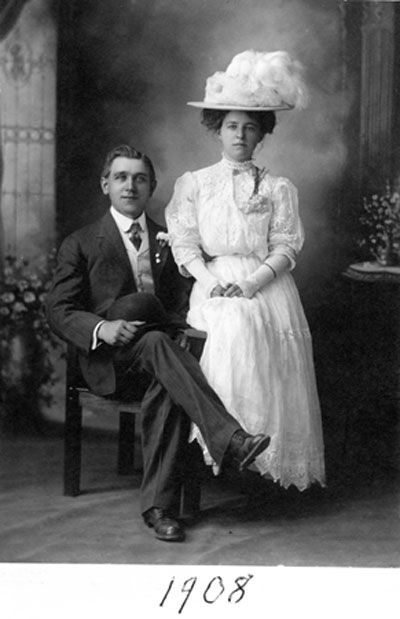
But all the ethnic groups shared something similar. The women kept their minds on their immediate tasks, careful not to worry too far beyond them. They were careful, too, never to let a miner leave the house in anger. Anger could distract a man underground, where the slightest carelessness could get him killed.
The second Hanna disaster
The boom that Mary Hughes and her father heard in their kitchen was the sound of the No. 1 Mine exploding again—the second time in five years. Big rocks and mine timbers blew out of the mine’s two entrances, followed by thick, rolling dust. The main entrance was clogged, but the east entrance was still open. As Charles Hughes arrived, the men quickly organized into two groups. One group began digging to clear the main entrance. The second went down into the mine through the east entrance, looking for survivors—or bodies.
Bruno Stebner and Charles Hughes worked with the rescue party. Some hours later, Bruno was heading down the slope with a load of tools when he encountered Charles heading up with a group of four men carrying a heavy body. They traded places so that the younger man could help carry the corpse. Charles went back down into the mine with the tools. At the surface, Bruno and the other men left the body in a shack and hurried back toward the east entrance. By now, it was night. Charles was delivering tools to more rescuers, far down in the mine. Mary had finished the pudding long ago.
Boom! came a second explosion. Eighteen men had been trapped underground by the first blast. Forty-one more were underground when the second blast came. Mary, as instructed, stayed home and waited for the news. Long after dark, Bruno knocked on the door. Her father, he told her, was certainly killed. The two blasts left 31 new widows and 103 children without fathers.
An avoidable accident
But perhaps the worst blow was the discovery that the blast had been avoidable. Under a system called gouging, the company mined the coal as it dug the hole. That is, the entries off the main slope were opened and mined as the slope was dug farther downward. This meant miners were always working below and beyond big rooms now empty of coal, but very likely to fill with gases that might explode at any time.
The right way to do it, mine inspector Noah Young wrote the governor of Wyoming later that month, after the explosions, would have been to dig the main slope all the way down first, and then mine back upward. Then the abandoned rooms could be allowed to fill with water, and the miners would never work below empty spaces filled with dangerous gas. “The [coal] seam,” Young wrote the governor, “could have been worked without a single explosion.”
Bruno, Mary and their children
A few months later, Bruno and Mary were married. He looks happy and confident in their wedding photo, but she only looks young, and very sad.
In July 1908, three months after the explosions, the company reopened the mine, and 27 bodies were recovered. The others, including Charles Hughes, were left in the mine.
No. 1 Mine was a tomb now and stayed closed. The following April, Mary bore her first child, Charles Stebner—Charlie, the family called him. Two years later, Elsie was born, and two years after that, LeRoy. Eighty years later, when Charlie wrote a book about his family and his town, he recalled that his mother was happiest during those years when the children were coming.
Bruno ran a side business fixing watches, clocks, guns—anything mechanical. He repaired the radiator on the first automobile that motored through Hanna. And, he ran the movie projector at Hanna’s old opera house. Bruno taught himself to read and write, and he taught Mary, who had so little schooling herself, the same skills.
Soon he had a much better job than mining coal. Because he was good with machines, the company put him in charge of the steam engine that pulled the cables bringing the loaded coal cars up the slope and out of the mine.
Every steam engine has a boiler, like a huge teakettle. Inside, water is heated to create steam, and pressure increases, which runs the engine. From time to time the hard, scaly mineral deposits that formed on the inside of the boilers needed to be cleaned out.
One day, when Bruno was cleaning the boiler, a valve got turned by mistake. Live steam poured into the boiler from a second boiler, next to it. In horrible pain and shock, Bruno managed to climb from the manhole and walk out of the building before collapsing. He was badly burned. An ambulance wagon took him home to No. 77. The company doctor did what he could for Bruno, and family members paid visits to the small, darkened bedroom. In spite of the pain, Bruno was rational and knew who everyone was.
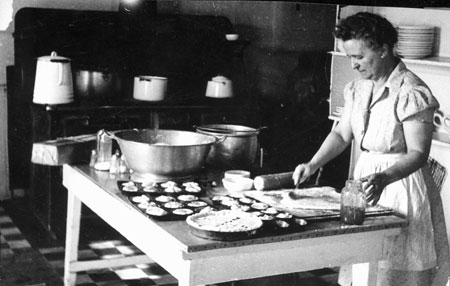
Bruno put his hand on 5-year-old Charlie’s head and smiled. Charlie cried. He forever afterward remembered the patchy look of the skin on his father’s hands, face and throat, and how his Adam’s apple—the skin nearly burned off it—moved as he spoke: “Charlie, you are the man of the house now. Take care of your mother.” Bruno died the next day. This was May 1914.
Mary’s boarding house
Mary, a widow now with three young children, was only 23. She collected $1,000 in life insurance from a policy Bruno had bought, and the miners’ union contributed about $800. The company waived the rent on their house for a while. Along the railroad tracks, the children picked up coal that had fallen out of train cars to fuel the family stove.
After Bruno’s death, Mary ran a boarding house, full mostly of single miners. She was only 5 feet tall. “Little Mary” she’d been called in Lancashire, the name came with her to Hanna and her miner customers used it, too. She cooked for them, she did their laundry, she packed their lunches every day. The miners drank sometimes. They gambled. They poached deer; they got in trouble in other ways. Still, she kept things running steadily, and people in Hanna over the decades came to love and admire her.
Mary married again, this time a man named Fred Ford. Charlie never liked him. Fred Ford drank and gambled and spent a lot of the money Mary made running the boarding house. After he died, there was more money in the family.
Dangers continue
Coal mining, meanwhile, remained dangerous. Between 1912 and 1938, 160 more miners were killed in Wyoming in accidents involving five or more men. Others continued to be killed in ones and twos. The worst disaster in those years happened August 1923, when 99 men died in an explosion in a mine near Kemmerer. The Legislature continued to pass more laws strengthening safety rules and giving the inspectors more authority and more staff.
Charlie’s brother and sister suffered many infections. LeRoy died of meningitis about 1919, and Elsie succumbed five years later to a kidney infection. By the time Mary was in her early thirties, she had lost her mother, her father, two husbands and two children. She continued to run the boarding house. Charlie went to college and then dental school. He became a well-respected dentist in Laramie. His son, Ken Stebner, retired recently after serving as a district court judge in Rawlins, and his daughter, Marilyn Stebner Kite, is as of October 2013 chief justice of the Wyoming Supreme Court.
When Mary Ford finally retired from the boarding house, more than 300 people turned out in Hanna to bid her farewell. She moved to Laramie to live near her son Charlie and died when she was 93 years old.
Empty holes
Every one of those coal-mine deaths through the decades represents an emptiness, a gap in a family, like the gaps left in the life of Mary Hughes Stebner Ford by the deaths of her mother, her father, two husbands and two children. And all of Wyoming’s former coal towns--some gone, some getting by and some booming again from other kinds of development--have big, empty places underneath them: the slopes, the entries and the rooms where all that coal was mined.
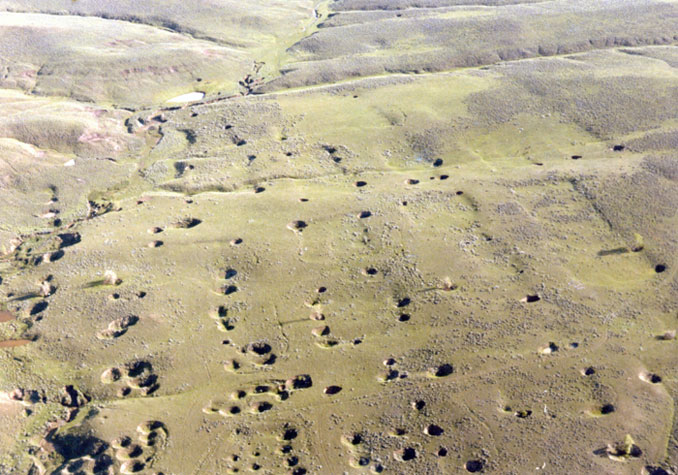
Resources
Primary Sources
- Groutage, Lorenzo. Wyoming Mine Run. Kemmerer, Wyo.: Published by the author, 1981. A memoir of life in the coal mines and coal towns of Lincoln County.
- Stebner, Charles M. Letters to Dear Dan. Laramie, Wyo.: privately published, 1989. Charlie Stebner’s memoir about his family—the Hugheses and the Stebners—and about life in Hanna in the first half of the 20th century, including many photographs, served as my main source for this account. The central figure in the book, which is available in most Wyoming libraries, is Charlie’s mother, Mary Hughes Stebner Ford.
Secondary Sources
- Allen, James B. The Company Town in the American West. Norman, Okla.: University of Oklahoma Press, 1966. A good general discussion, with specifics on Hanna pp. 53-57.
- Andersen, Chamois L. “The Coal Business in Wyoming.” WyoHistory.org. Accessed Oct. 28, 2013, at /encyclopedia/coal-business-wyoming.
- Anderson, Nancy. “Hanna.” Unpublished manuscript, 2007. Hanna, Wyo.
- Kalisch, Philip A. “The Woebegone Miners of Wyoming: A History of Coal Mine Disasters in the Equality State.” Annals of Wyoming, 42 (Oct. 1970), 237-242.
- Larson, T.A. History of Wyoming. Lincoln: University of Nebraska Press, 1965. 113-115, 142, 196, 230, 298, 336-337.
- Roberts, Phil. “Frontier Wyoming’s Most Dangerous Occupation: The Quest for Mine Safety in Wyoming’s Coal Industry,” Accessed Nov. 1, 2013 at http://www.uwyo.edu/robertshistory/coal_safety_07.htm. Details on Wyoming coal mine disasters and government attempts at reform from the earliest days through the 20th century. The article is one of many pages on University of Wyoming History Professor Phil Roberts’ useful website on Wyoming history.
For Further Reading and Research
- Leathers, Bob. “Hanna, Carbon, Wyoming Coal Mine Fatality Records.” Hanna Basin Museum. Accessed Oct. 28, 2013, at http://www.hannabasinmuseum.com/hanna-mine-fatality-records.html.
- Mine Safety and Health Administration. “Coal Mining Fatalities by State by Calendar Year as of 10/17/2013.” Accessed Oct. 28, 2013, at http://www.msha.gov/stats/charts/coalbystates.pdf. The figures show that people continue to die mining coal. By far, the most deaths occur in underground mines. From 2002 through October 2013, eight people died in Wyoming coal mines. In West Virginia, 129 died; in Kentucky, 87 died; in Alabama, 24; in Virginia, 16; in Utah, 15. In those states, most of the coal still comes from underground mines.
- Racina, Gay Houchen. “Hanna Cemetery, Hanna, Carbon County, Wyoming.” Accessed Oct. 28, 2013, at http://www.interment.net/data/us/wy/carbon/hanna/hanna.htm. Information on the Hanna cemetery, including lists of people buried there and photographs of a memorial stone for Hanna miners who were killed in the mines.
Illustrations
- The Wyoming State Archives picture of the miner at the mouth of No. 1 mine and the images of the newspaper headlines are from the website of the Hanna Basin Museum, with thanks to Nancy Anderson and Bob Leathers.
- The 1900 photo of Two Town is from the S.H. Knight Collection at the American Heritage Center, University of Wyoming. Used with permission and thanks.
- The photos of Bruno and Mary Hughes Stebner on her wedding day and of Mary with her biscuits and pies, are courtesy of Kenneth Stebner, and used with thanks.
- The aerial photo showing mine subsidence is from the U.S. Geological Survey’s photo website. Used with thanks.
